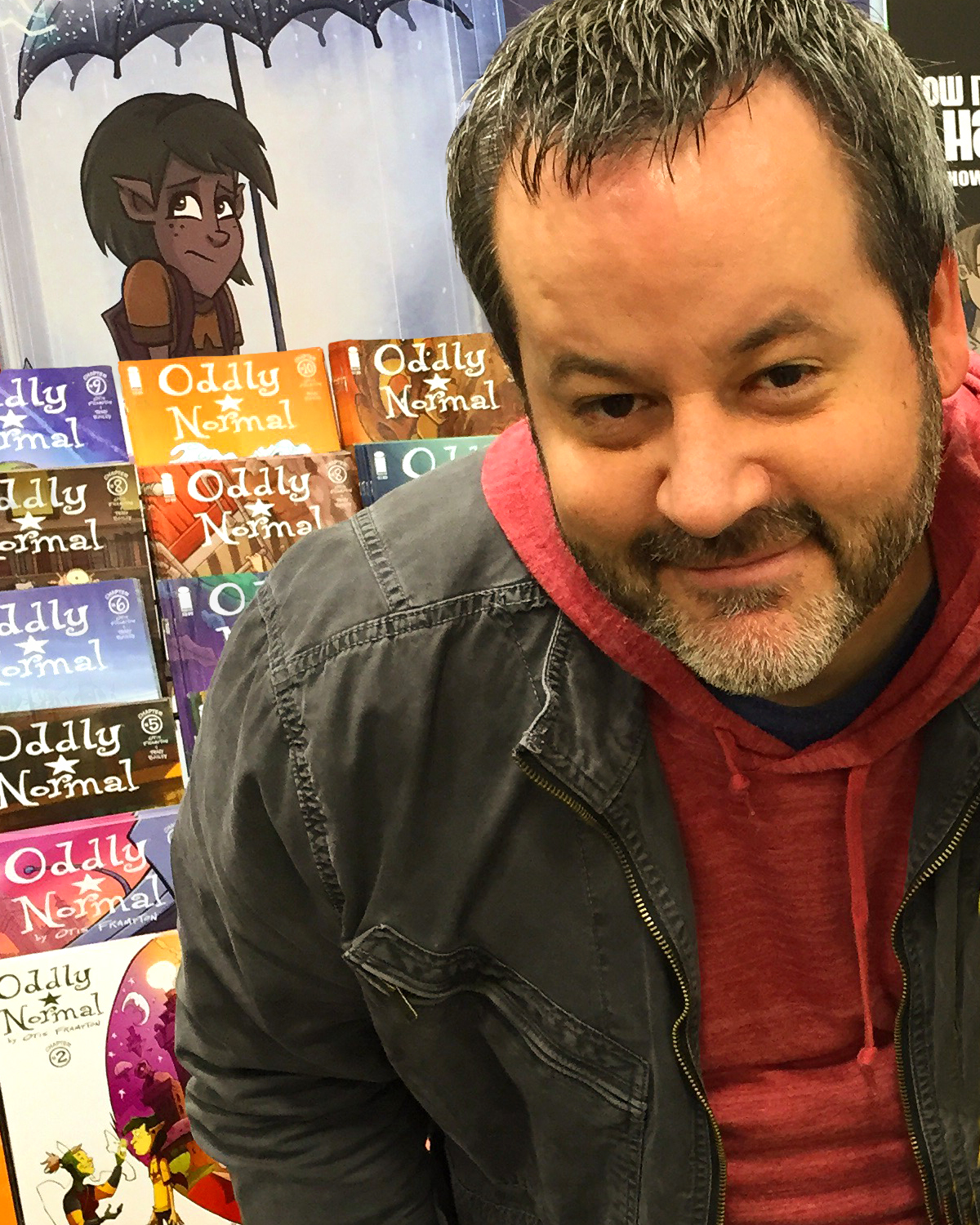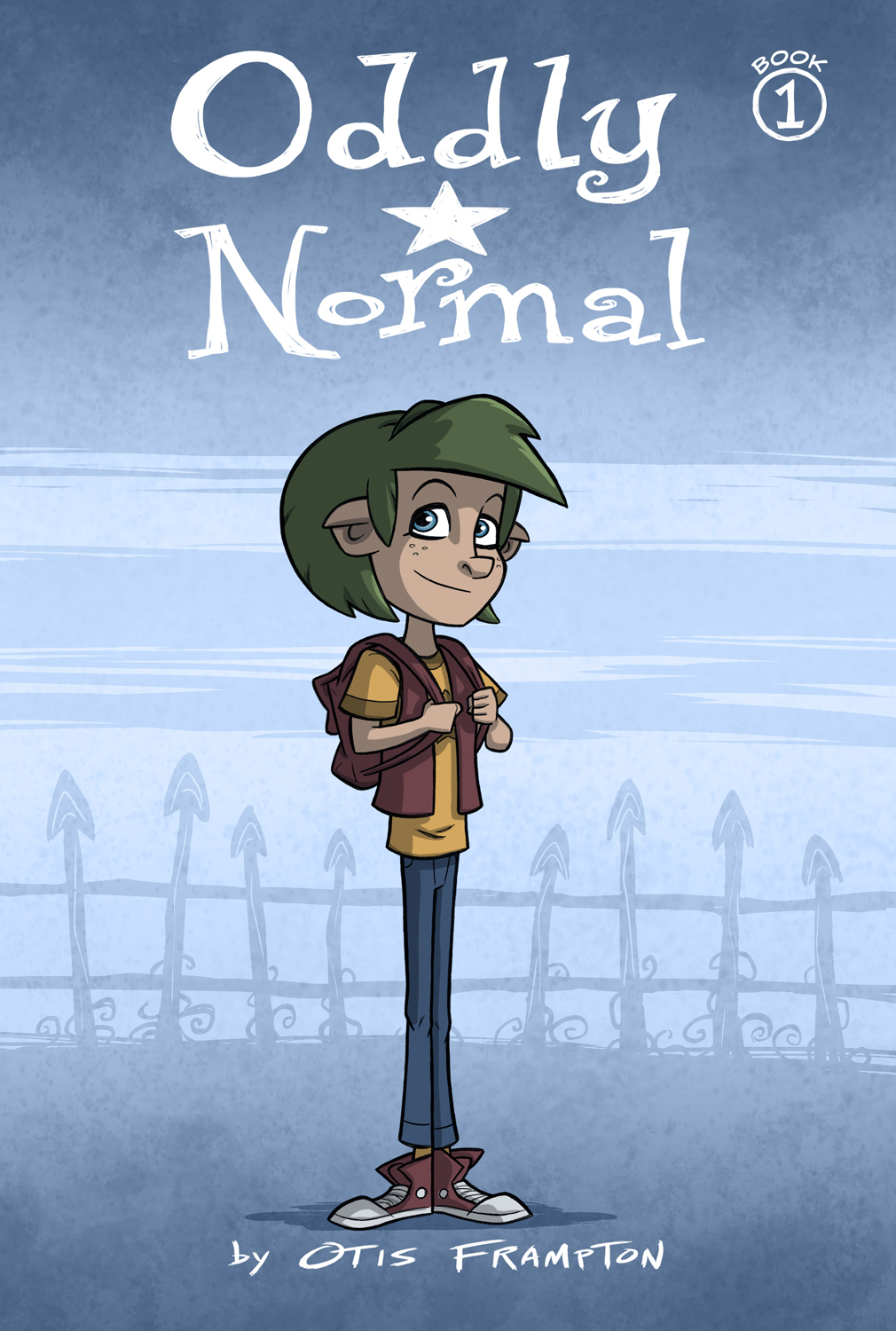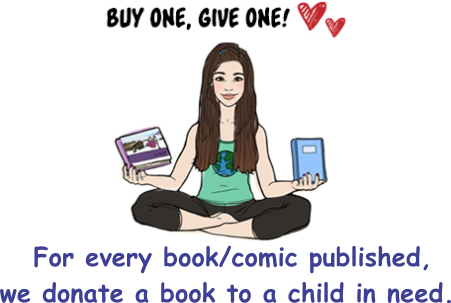 ABOUT OTIS FRAMPTON
ABOUT OTIS FRAMPTONOtis Frampton is the creator of the graphic novel series Oddly Normal (published by Image Comics) and the webcomic/animated series ABCDEFGeek. He is also one of the two artists on the popular animated web series "How It Should Have Ended". He enjoys drawing and pizza, often at the same time.
 ABOUT ODDLY NORMAL
ABOUT ODDLY NORMALOddly Normal is a ten year old girl with pointed ears and green hair. Her mother is a witch from the land of Fignation and her father is a human from Earth. On her tenth birthday, Oddly makes a disastrous wish over her birthday candles and her parents vanish from existence. Oddly must got to Fignation to live with her great-aunt and attempt to discover the mystery of her parents disappearance. But life in Fignation will not be easy for her as she much do battle with vampires, werewolves and ultimately... Evil itself!
Q: Who or what were the biggest influences on you when you began your career as an artist?
A: My biggest influences are and always have been great stories. Books, films, comics... it didn't matter. I have always loved good stories. And I’ve written stories as long as I’ve been drawing, since I was a young child. I’m always trying to absorb and be influenced by great stories and storytellers, be they writers or artists. I think the biggest influences on “Oddly Normal” have been “The Wizard of Oz,” “Kiki’s Delivery Service” and the novel “Wicked.” But everything I read or see can have an influence of what I'm working on. As a writer and artist, it's important to let everything (the good AND the bad) influence your direction and a creative person and shape your personal style.
Q: Graphic Novels have really taken off. What do you attribute the success to?
A: I think the biggest factor is that parents who grew up reading comics are passing along that pastime to their kids. The adults who were raised on comics as a source of storytelling have normalized the medium of comics. It’s about a new generation being introduced to comics as a legitimate art form in a way that my generation didn't get from our parents. I discovered comics on my own as a child at a time when they were considered, well... trash. The medium of comics has only gotten respect as an art form because of people who grew up reading them and then passing them on to their kids.
Q: You have spent years working on Oddly Normal, revising how it is published and with whom, and how you tell and share this story. Can you tell us a bit about the history of Oddly Normal and where you hope it will end up?
A: Oddly started her life as a random sketch in my sketchbook in 1999. I drew a sad little girl and wrote the words “oddly normal” next to her. From there, I started to think about her story and turned it into a webcomic, which was then turned into a comic book limited series with Viper Comics. After Viper ceased publishing, I got a literary agent and we shopped the book around to various publishers, hoping to re-start the series fresh. We almost got picked up by a big publisher, but they ultimately passed and I lost my agent. After that, I decided togo it alone and started working on a new version of the series. I was never happy with the artwork on the original Viper version and was frustrated that I had a limited number of pages to tell the story. I had to abandon a lot of material to make that original limited series. When I had a couple of chapters complete, I printed up two issues and pitched them out to seven different publishers. I got offers from two and chose to go with Image Comics. It’s been a long road to get here, but I’m finally working on the version of “Oddly Normal” that I always envisioned! My current plan is to produce about 20 books to complete Oddly’s story. I’ve also been working with producers to develop an animated series based on the comic, so hopefully that will see the light of day soon!
Q: When you created Oddly Normal, did you start with the story, the character, or the illustrations? How do you explain to kids how to write a graphic novel?
A: I always start with story and character. Or character and story. Either way, you’re talking about the same thing. Story IS character. When writing, I’m always asking “who is this character, what does he/she want and what is keeping him/her from getting that.” Ultimately, your story IS your character. My advice to kids wanting to write a graphic novel is to not think of it as writing a graphic novel. Tell a good story first and then see if it is also a visual story. Graphic novels are a hybrid medium of words and pictures. So if your story has potentially great visuals, you may have a graphic novel. Otherwise, just write it out in words and you’ve got the start of a book!
Q: Writers often pull from their past in creating their work. Did you use any of your past experiences in creating Oddly Normal? Bullying? Friendships? Parents?
A: Absolutely. Oddly and I have a lot in common. We both started at new schools in the middle of a school year and were tormented by bullies from the beginning. I feel very close to Oddly. Its always amazing to me when people tell me they relate so closely to her, because there's so much of me in her. But I’ve never wished my parents would disappear!
Q: Oddly is such a rich character, an outcast on a journey of self-discovery. What do you want people to take away or remember most about Oddly?
A: That’s she’s really just a normal kid who has to use her wits, courage and kindness to get through the trials and tribulations that life throws at her. She’s “oddly normal,” not “odd.” She doesn’t have a magic wand, she doesn’t use the Force and doesn’t have any mutant powers. She’s an average kid who happens to have pointed ears and green hair. That’s it. And I think that what makes her special is that she doesn’t have anything magical or fantastical to fall back on when times get tough. But that’s okay.
Q: You have a great way of hooking the reader with your series in that the issues are like chapters in a long novel, for sale in books of 5 chapters each. How can you explain to young authors how to create a hook to ensure the reader wants to read the next book?
A: Always leave an audience wanting more. I learned that when I was 8 years old and I saw “The Empire Strikes Back.” Everyone I knew was frustrated by the ending… or non-ending, as it were. But to me, it was brilliant. I left the movie theater immediately wanting to see the next film, but also realizing how wonderful it was to have to wait. By telling a fantastic story and leaving the audience wanting more by not wrapping everything up at the end, you create a strong desire to come back for more. This applies to the ends of books, chapters and ever individual scenes. Many comic book writers like to think in arcs and write for the eventual trade paperback version, making sure that each 5 issue (or chapter) arc is complete. I don’t like to think that way. I think that if I write characters that the reader finds engaging, they will accept it if I don’t tie up stories in a way that is completely satisfying. Sometimes it’s more satisfying to be left wanting more!
A: My biggest influences are and always have been great stories. Books, films, comics... it didn't matter. I have always loved good stories. And I’ve written stories as long as I’ve been drawing, since I was a young child. I’m always trying to absorb and be influenced by great stories and storytellers, be they writers or artists. I think the biggest influences on “Oddly Normal” have been “The Wizard of Oz,” “Kiki’s Delivery Service” and the novel “Wicked.” But everything I read or see can have an influence of what I'm working on. As a writer and artist, it's important to let everything (the good AND the bad) influence your direction and a creative person and shape your personal style.
Q: Graphic Novels have really taken off. What do you attribute the success to?
A: I think the biggest factor is that parents who grew up reading comics are passing along that pastime to their kids. The adults who were raised on comics as a source of storytelling have normalized the medium of comics. It’s about a new generation being introduced to comics as a legitimate art form in a way that my generation didn't get from our parents. I discovered comics on my own as a child at a time when they were considered, well... trash. The medium of comics has only gotten respect as an art form because of people who grew up reading them and then passing them on to their kids.
Q: You have spent years working on Oddly Normal, revising how it is published and with whom, and how you tell and share this story. Can you tell us a bit about the history of Oddly Normal and where you hope it will end up?
A: Oddly started her life as a random sketch in my sketchbook in 1999. I drew a sad little girl and wrote the words “oddly normal” next to her. From there, I started to think about her story and turned it into a webcomic, which was then turned into a comic book limited series with Viper Comics. After Viper ceased publishing, I got a literary agent and we shopped the book around to various publishers, hoping to re-start the series fresh. We almost got picked up by a big publisher, but they ultimately passed and I lost my agent. After that, I decided togo it alone and started working on a new version of the series. I was never happy with the artwork on the original Viper version and was frustrated that I had a limited number of pages to tell the story. I had to abandon a lot of material to make that original limited series. When I had a couple of chapters complete, I printed up two issues and pitched them out to seven different publishers. I got offers from two and chose to go with Image Comics. It’s been a long road to get here, but I’m finally working on the version of “Oddly Normal” that I always envisioned! My current plan is to produce about 20 books to complete Oddly’s story. I’ve also been working with producers to develop an animated series based on the comic, so hopefully that will see the light of day soon!
Q: When you created Oddly Normal, did you start with the story, the character, or the illustrations? How do you explain to kids how to write a graphic novel?
A: I always start with story and character. Or character and story. Either way, you’re talking about the same thing. Story IS character. When writing, I’m always asking “who is this character, what does he/she want and what is keeping him/her from getting that.” Ultimately, your story IS your character. My advice to kids wanting to write a graphic novel is to not think of it as writing a graphic novel. Tell a good story first and then see if it is also a visual story. Graphic novels are a hybrid medium of words and pictures. So if your story has potentially great visuals, you may have a graphic novel. Otherwise, just write it out in words and you’ve got the start of a book!
Q: Writers often pull from their past in creating their work. Did you use any of your past experiences in creating Oddly Normal? Bullying? Friendships? Parents?
A: Absolutely. Oddly and I have a lot in common. We both started at new schools in the middle of a school year and were tormented by bullies from the beginning. I feel very close to Oddly. Its always amazing to me when people tell me they relate so closely to her, because there's so much of me in her. But I’ve never wished my parents would disappear!
Q: Oddly is such a rich character, an outcast on a journey of self-discovery. What do you want people to take away or remember most about Oddly?
A: That’s she’s really just a normal kid who has to use her wits, courage and kindness to get through the trials and tribulations that life throws at her. She’s “oddly normal,” not “odd.” She doesn’t have a magic wand, she doesn’t use the Force and doesn’t have any mutant powers. She’s an average kid who happens to have pointed ears and green hair. That’s it. And I think that what makes her special is that she doesn’t have anything magical or fantastical to fall back on when times get tough. But that’s okay.
Q: You have a great way of hooking the reader with your series in that the issues are like chapters in a long novel, for sale in books of 5 chapters each. How can you explain to young authors how to create a hook to ensure the reader wants to read the next book?
A: Always leave an audience wanting more. I learned that when I was 8 years old and I saw “The Empire Strikes Back.” Everyone I knew was frustrated by the ending… or non-ending, as it were. But to me, it was brilliant. I left the movie theater immediately wanting to see the next film, but also realizing how wonderful it was to have to wait. By telling a fantastic story and leaving the audience wanting more by not wrapping everything up at the end, you create a strong desire to come back for more. This applies to the ends of books, chapters and ever individual scenes. Many comic book writers like to think in arcs and write for the eventual trade paperback version, making sure that each 5 issue (or chapter) arc is complete. I don’t like to think that way. I think that if I write characters that the reader finds engaging, they will accept it if I don’t tie up stories in a way that is completely satisfying. Sometimes it’s more satisfying to be left wanting more!







